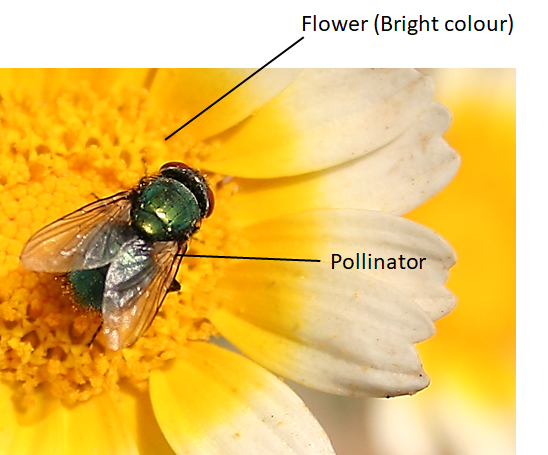
Entomophily is pollination by
(a) Water
(b) Animals
(c) Air
(d) Insects
Answer
572.4k+ views
Hint: Pollination is the process of transfer of pollen grains from the male of a flower to the female stigma.
Complete answer:
If the pollinating agents are insects then it is called entomophily. Insects like bees, butterflies, moths, wasps, flies, ants, and beetles are reported to be responsible for the pollination of many plant species. In Salvia, the pollinating agents are insects and there is a special mechanism called a lever mechanism or turn pipe mechanism. The lever present in the plant causes the stamens to move and the pollen to be deposited on the pollinator who visits for nectar. The lever returns to its original position after the pollinator leaves the flower.
- Pollination is important because it leads to the production of fruits and seeds which in turn can create more plants.
- Pollinators receive nectar and/or pollen rewards from the flowers like sugary nectar provides pollinators with carbohydrates while pollen offers proteins, fats, vitamins, and necessary phytochemicals.
- The offspring produced is usually healthy, viable, and stronger.
- Two types of pollination- The transfer of pollen from another plant to the flower of another plant is known as cross- pollination. The pollination of a flower by pollen from the same flower or another flower on the same plant is known as self- pollination.
- In plants, after pollination, fertilization occurs when haploid gametes (pollen grain and egg) by certain agents meet to create a diploid zygote, leading to an embryo.

So, the correct answer is ‘Insects’.
Note:
- Elements such as animals (insects, birds, and bats, etc.), water, wind, and even plants themselves are pollinating agents.
- Pollination by the agency of ants is called myrmecophily, pollination by the agency of bats is called chiropterophily, and pollination by the agency of birds is called ornithophily.
Complete answer:
If the pollinating agents are insects then it is called entomophily. Insects like bees, butterflies, moths, wasps, flies, ants, and beetles are reported to be responsible for the pollination of many plant species. In Salvia, the pollinating agents are insects and there is a special mechanism called a lever mechanism or turn pipe mechanism. The lever present in the plant causes the stamens to move and the pollen to be deposited on the pollinator who visits for nectar. The lever returns to its original position after the pollinator leaves the flower.
- Pollination is important because it leads to the production of fruits and seeds which in turn can create more plants.
- Pollinators receive nectar and/or pollen rewards from the flowers like sugary nectar provides pollinators with carbohydrates while pollen offers proteins, fats, vitamins, and necessary phytochemicals.
- The offspring produced is usually healthy, viable, and stronger.
- Two types of pollination- The transfer of pollen from another plant to the flower of another plant is known as cross- pollination. The pollination of a flower by pollen from the same flower or another flower on the same plant is known as self- pollination.
- In plants, after pollination, fertilization occurs when haploid gametes (pollen grain and egg) by certain agents meet to create a diploid zygote, leading to an embryo.

So, the correct answer is ‘Insects’.
Note:
- Elements such as animals (insects, birds, and bats, etc.), water, wind, and even plants themselves are pollinating agents.
- Pollination by the agency of ants is called myrmecophily, pollination by the agency of bats is called chiropterophily, and pollination by the agency of birds is called ornithophily.
Recently Updated Pages
Master Class 12 Business Studies: Engaging Questions & Answers for Success

Master Class 12 Economics: Engaging Questions & Answers for Success

Master Class 12 English: Engaging Questions & Answers for Success

Master Class 12 Maths: Engaging Questions & Answers for Success

Master Class 12 Social Science: Engaging Questions & Answers for Success

Master Class 12 Chemistry: Engaging Questions & Answers for Success

Trending doubts
What are the major means of transport Explain each class 12 social science CBSE

Which are the Top 10 Largest Countries of the World?

Draw a labelled sketch of the human eye class 12 physics CBSE

How much time does it take to bleed after eating p class 12 biology CBSE

Explain sex determination in humans with line diag class 12 biology CBSE

Differentiate between homogeneous and heterogeneous class 12 chemistry CBSE




